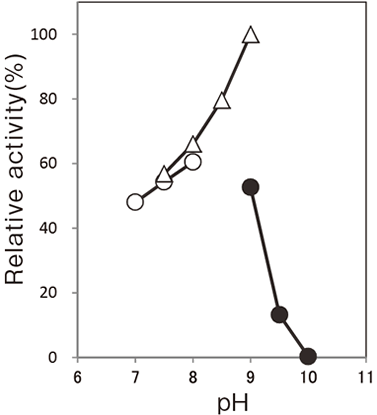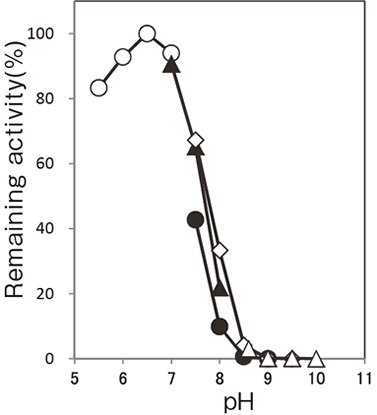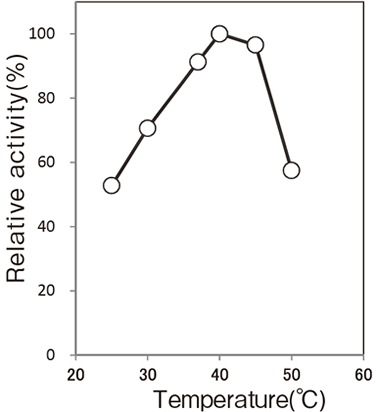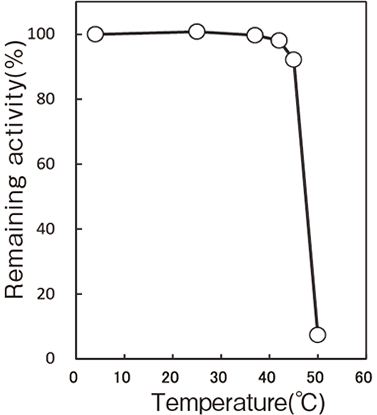GLYCEROL-3-PHOSPHATE DEHYDROGENASE [G3PDHⅡ]
from Saccharomyces cerevisiae
(sn-glycerol-3-phosphate:NAD+ 2-oxidoreductase, EC 1.1.1.8)
sn -glycerol 3-phosphate + NAD+ ↔ glycerone phosphate + NADH + H+
Preparation and Specification
- Appearance
- : White lyophilized powder
- Specific activity
- : More than 37.0 U/mg solid
- Contaminants
- : NADH oxidase Less than 0.00015 %(U/U)
Properties
- Substrate specificity
- : The enzyme is specific for sn-glycerol 3-phosphate and NAD(H)
- Molecular weight
- : 45.6 kDa (SDS-PAGE)
- Isoelectric point
- : pH 4.8-5.3
- Michaelis constants
- : sn-glycerol 3-phosphate 1.4 × 10-2 M (8.5 mM NAD)
- : NAD 4.6 × 10-4 M (75 mM sn-glycerol 3-phosphate)
- Optimum pH
- : 9.0Figure 1
- pH stability
- : 6.0–7.0 (37℃, 60 min) Figure 2
- Optimum temperature
- : 40℃Figure3
- Thermal stability
- : Stable at 45℃ and below (pH 6.5, 30 min)Figure4
- Inhibitor1)
- : ATP, ADP, fructose 1,6-bisphosphate
Applications for Diagnostic Test
The enzyme is useful for enzymatic determination of triglyceride (TG) coupled with LP (Lipase; T-01, T-63, or T-116) and GK (Glycerol kinase; T-64 or T-223).
| LP | ||
| TG + 3H2O | → | Glycerol + 3 Fatty acid |
| GK | ||
| Glycerol + ATP | → | G-3-P + ADP |
| G3PDHⅡ | ||
| G-3-P + NAD+ | → | DHAP + NADH + H+ |
G-3-P: sn-Glycerol 3-phosphate
DHAP: Dihydroxyacetone phosphate
Assay
Principle
-
This assay is based on the increase in absorbance at 340 nm as the formation of NADH proceeds in the following reactions:
| G3PDH Ⅱ | ||
| sn-glycerol 3-phosphate + NAD+ | → | glycerone phosphate + NADH |
NAD: Nicotinamide adenine dinucleotide
Unit definition
-
One unit is defined as the amount of enzyme which generates 1 μmole of NADH per minute at 37 ℃ under the conditions specified in the assay procedure.
Reagents
- Reaction mixture
Combine 1.632 g of Bicine with about 70 ml of distilled water, and adjust pH to about 8.5 at about 25 ℃ with 1N NaOH (Bicine will dissolve after adjusting pH). Add 4.727 g of Disodium Glycerophosphate 5.5-hydrate and 0.564 g (based on pure product) of NAD, dissolve them, add distilled water to make up to about 90 ml, and adjust pH to 8.7 at
25 ℃ with 1N NaOH. Finally add distilled water to make up to 100 ml. - Enzyme dilution buffer
Dissolve 1.211 g of tris (hydroxymethyl) aminomethane with 800 ml of distilled water, and adjust pH to 7.5 at 25 ℃ with 1N HCl. Add 1 g of BSA, dissolve it, check the pH of the solution again, and add distilled water to make 1 L solution. - Reagent
Bicine: Dojindo Laboratories #347‒03282
Disodium Glycerophosphate 5.5-hydrate:FUJIFILM Wako Pure Chemical Corporation Special grade #192-02055Tris (hydroxymethyl) aminomethane:Sigma Chemical Co. #T‒1503
BSA: Millipore Fraction V pH 5.2 # 81‒053
NAD: FUJIFILM Wako Pure Chemical Corporation#304-50443
Enzyme solution
-
Accurately weigh about 20 mg of the sample and add enzyme dilution buffer to make a total of 20 ml. Dilute it with enzyme dilution buffer to adjust the concentration as required
Procedure
- Pipette accurately 2.00 ml of reaction mixture into a small test tube and preincubate at 37 ℃.
- After 5 min. add accurately 20 μl of enzyme solution and mix to start the reaction at 37 ℃.
※ In the case of a test blank, add 20 μl of enzyme dilution buffer in place of enzyme solution. - After starting the reaction, measure the rate of increase per minutes in absorbance at 340 nm. The rate must be measured within the linear portion of the absorbance curve.
ΔA/min =( As/min - Ab/min) ≦ 0.15Abs/minAbsorbance sample : As/min blank : Ab/min
Calculation
- Activity (U/mg of powder) = (ΔA/min)/6.22 × 2.02/0.02 × 1/x × D
6.22 : millimolar extinction coefficient of NADH at 340 nm ( cm2 /μmole) 2.02 : final volume (ml) 0.02 : volume of enzyme solution (ml) X : concentration of the sample in enzyme solution ( mg/ml) D : times of dilution in enzyme solution
Storage
-
Storage at -20 ℃ in the presence of a desiccant is recommended.
References
- Albertyn J., van Tonder A., Prior BA. (1992) FEBS Lett., 308(2), 130-132.72, 972.
- Miura, M., et al., (1989) J. Clin. Lab. Inst. Reag., 12(5),1005-1009.
G3PDH Ⅱ活性測定法 (Japanese)
試薬液
- 反応試薬混合液
Bicine 1.632 g を精製水約70 ml に混合し、1N NaOH で約pH8.5 (約25℃) に調整する (pH 調整するとBicine は溶解する) 。さらにグリセロりん酸二ナトリウム5.5 水和物4.727 g とNAD 0.564 gを加えて溶解したあと、精製水を加えて全容を約90 ml とし、1N NaOH でpH8.7 (25℃) に調整する (NAD は純度換算する) 。最後に精製水で全容を100 ml とする。 - 酵素溶解希釈用液
トリス (ヒドロキシメチル) アミノメタン 1.211 gを精製水800ml に溶解した後、1N HCl でpH7.5 (25℃) に調整し、BSA を1 g 加えて溶解し、再度pH を確認した後、精製水で1 L とする。 - 試薬
Bicine (ビシン) : 同仁化学製 #347‒03282
グリセロりん酸二ナトリウム5.5 水和物 :富士フイルム和光純薬製 特級 #192-02055トリス (ヒドロキシメチル) アミノメタン:シグマ社製 #T‒1503BSA:Millipore 社製 Fraction V pH5.2 #81‒053
NAD (ニコチンアミドアデニンジヌクレオチド・酸化型) :富士フイルム和光純薬製 #304-50443
酵素試料液
- 検品約20 mg を精密に量り、酵素溶解希釈用液で溶解して全容20 ml とする。
その液を酵素溶解希釈用液で適宜希釈する。
測定操作法
- 小試験管に反応試薬混合液 2.00ml を正確に分注し、37°Cで予備加温する。
- 5分経過後、酵素試料液 20 μlを正確に加えて混和し、37℃で反応を開始する。
※ 盲検は酵素試料液の代わりに酵素溶解希釈用液 20μl を加える。 - 反応開始後、340 nmにおける吸光度を測定して直線的に反応している1分間当たりの吸光度変化を求める。
求められた吸光度変化を試料液についてはAs/min、盲検液についてはAb/min とする。
ΔA/min = (As/min-Ab/min) ≦ 0.15 Abs/min
計算
活性 (U/mg) = (ΔA/min)/6.22 × 2.02/0.02 × 1/x × D| 6.22 : | NADH の340nm におけるミリモル分子吸光係数 (cm2 / μmol) |
| 2.02 : | 反応総液量 (ml) |
| 0.02 : | 反応に供した酵素試料液量 (ml) |
| X : | 酵素試料液中の検品濃度 (mg/ml) |
| D : | 酵素試液の希釈倍率 |
Copyright © Asahi Kasei Pharma Corporation. All rights reserved.







